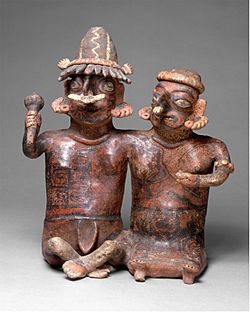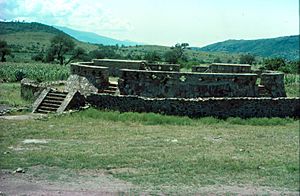Ixtlán del Rio (archaeological site) facts for kids
Quick facts for kids Shaft Tomb Tradition Culture – Archaeological Site |
||
| Name: | Ixtlán del Río Archaeological Site | |
| Type | Mesoamerican archaeology | |
| Location | Ixtlán del Rio, Nayarit |
|
| Region | Mesoamerica | |
| Coordinates | 21°02′23″N 104°20′41″W / 21.03972°N 104.34472°W | |
| Culture | Aztatlán Tradition - Nahua | |
| Language | Nahuatl | |
| Chronology | 300 BCE to 1521 CE | |
| Period | Mesoamerican Preclassical, Classical, Postclassical | |
| Apogee | 750 – 1100 CE | |
| INAH Web Page | Ixtlán del Río Archaeological site | |
Ixtlán del Río is an amazing ancient site in Nayarit, Mexico. It's also called "Los Toriles." This place shows us a lot about the old cultures that lived in western Mexico.
You can find ancient rock carvings, called petroglyphs, in five areas here. The most important ones are "El Terrero," "Sayulapa," and "El Veladero." These carvings show cool abstract shapes like spirals with rays.
Archaeologists have found five main areas with "Shaft Tombs." These are special burial places. Inside, they found human bones, pottery like ollas (pots), comales (flat griddles), and cantaros (pitchers). They also found sculptures of people and animals.
Contents
What Does Ixtlán Mean?
The name "Ixtlán" comes from the Nahuatl language. It combines "Itz-ittztell," which means obsidian, and "Tlán," meaning a place with lots of something. So, Ixtlán means "Place where obsidian is abundant."
Another idea is that Ixtlán means a place dedicated to Ehécatl, the Wind God.
A Journey Through Time at Ixtlán
This important site was likely first settled around 300 BCE (Before Common Era) and continued until about 600 CE (Common Era).
The Shaft Tomb Tradition
In the early days, a special culture called the "Shaft Tomb Tradition" developed. People would place offerings inside underground burial chambers. This tradition was popular between 300 BCE and 600 CE.
The Aztatlán Tradition Begins
Around 500 to 600 CE, the Shaft Tomb Tradition changed. A new way of life began, known as the Aztatlán Tradition. This period reached its peak between 750 and 1100 CE.
With the Aztatlán Tradition, a new lifestyle started around 750 to 900 CE. This time is called the mid-Ixtlán period (750 - 1110 CE). It was the city's golden age, and it was dedicated to Ehécatl, the Wind God. Later, from 1110 to 1525 CE, was the late Ixtlán period. During this time, people used smooth red pottery for everyday items. They also made bowls (cajetes) and tripod molcajetes (grinding tools) with white designs on red.
Founding the City
The city of Ixtlán was founded in the 12th century. It was built by Nahuatlaca tribes who were traveling towards the Valley of Mexico. They formed a powerful area called the Ahuacatlán Lordship. This group was known for building impressive structures and trading obsidian goods.
The city grew a lot during this time. People built large terraces, palaces, temples, and altars. Ixtlán became an important center for making goods and trading.
Exploring the Ancient City
Archaeologists have found more than 85 mounds and structures at the site. Many of these are still waiting to be explored! Today, you can visit about fifteen structures.
One of the most famous buildings is the Quetzalcoatl Temple. It's a circular building with a low wall around it. This wall has unique cross-shaped holes, almost like windows. The temple also has two altars on top, similar to those found in central Mexico.
Other important buildings include the "Reliefs Palace," the "Columns Palace," the "Four Column Palace" complex, and the "Square Palace."
Ixtlán is the most studied archaeological zone in Nayarit. Its influence reached many nearby towns.
Ancient Art: Petroglyphs and Pottery
Amazing Rock Carvings
In Santiago Ixcuintla, archaeologists have found petroglyphs from an old time called "Los Concheros." These carvings are at sites like Las Parejas, Emérita, Yago, El Caballo, and Acatán de las Piñas. There are 13 engravings in total, including one called "Piedra Galana."
As mentioned earlier, you can also find ancient rock carvings in five areas at Ixtlán del Río itself. The most important are "El Terrero," "Sayulapa," and "El Veladero." These carvings show lines and abstract shapes, like spirals with rays.
Colorful Ancient Pottery

The pottery from this time is very special. It helps us understand how western Mexico was different from other ancient cultures in Mesoamerica. The pottery from the early Ixtlán period (300 BCE to 300 CE) is found in the Nayarit shaft tomb complexes. Experts have identified three main styles of clay modeling: Chimisco, Ixtlán, and San Sebastian.
This pottery uses many colors, especially red, orange, yellow, and beige. It also features a "negative" painting style. Common themes on the pottery include warriors, musicians, women, sick people, and couples.
Exploring the Structures of Ixtlán
The Ixtlán del Río archaeological site has a main plaza. In the center, there's an altar with four small stairways. On the sides of the plaza, there are buildings that look like small rectangular rooms.
These temples or rooms are built on platforms. They have adobe pillars, sidewalks, and stairways.
One of these temples has a stone-paved road. This road leads to the famous round monument. This monument was discovered in 1948. It is 30 meters (about 98 feet) wide and 4 meters (about 13 feet) high. It has sloped walls with a special top edge that has cross-shaped holes. There are four stairways to access it.
On top of the monument, inside the round patio, there are pyramid bases. One is to the north and one to the south. These bases have stairs leading to the center. The north base has a smooth vertical panel, and the south has a slanted edge. These bases likely held small altars with column entrances and stone roofs. This monument is called the "Quetzalcoatl Temple." It's thought to have features similar to the Toltec culture.


